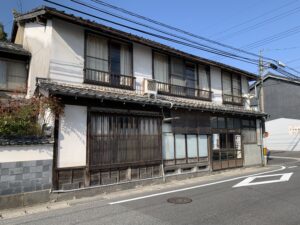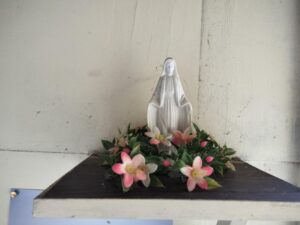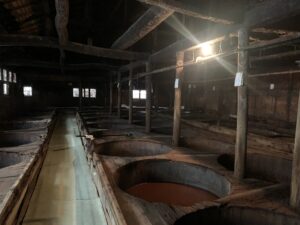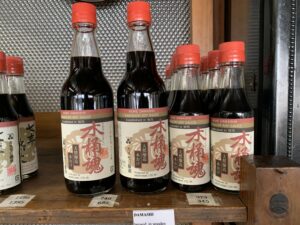Soy sauce (shoyu) is arguably the most crucial seasoning in Japan’s UNESCO-inscribed washoku cuisine. This traditional culinary culture emphasises seasonal ingredients, presentation and balance, and includes well-known dishes such as sushi, sashimi, sukiyaki, and teriyaki. It’s in every kitchen, used in nearly every meal, and placed on almost every table in Japanese restaurants. In 2013, when UNESCO designated washoku as an Intangible Cultural Heritage, there were fewer than 55,000 Japanese restaurants outside the country, but by 2023 that number had risen to nearly 190,000. As Japanese cuisine continues to gain new fans, worldwide interest in shoyu is rising.
The history of soy sauce spans millennia. In ancient China, foods such as meat and grains were widely fermented, and these techniques eventually reached Japan. It is thought that soy sauce production developed out of methods for fermenting soybeans and grains with salt, a tradition that goes back roughly 2,200 years. Soy sauce is often said to have been introduced to Japan by a monk in the mid-13th century, and by the late 16th century, a seasoning not too different from modern soy sauce had come into common use. In the following centuries, distinct styles emerged in line with regional food cultures.
Against this long, quietly evolving history stands Kanemori Shoyu in Matsue, a small castle town in Shimane Prefecture where soy sauce is still brewed the old-fashioned way in towering wooden barrels called kioke.
Kanemori Shoyu’s Historical Significance
Since 1875, Kanemori Shoyu has played a vital role as a soy sauce producer, enriching the kitchens of Matsue for generations in the Ishibashi-cho neighbourhood northeast of Matsue Castle. The historic feudal castle is known for its impressive architecture and significance in Japanese history. Steeped in tradition and prestige, this part of the castle town was historically a merchant district supporting the samurai class.
Ishibashi, meaning ‘stone bridge’ in English, is named after the large stone bridge over the river, where riverboats carrying cargo used to come and go. Matsue Castle is visible from many points in the area, with its Japanese tile roofs, latticed windows lining the streets, and several small paths that give a sense of the neighbourhood’s depth. The whole area has a calm ambience, where you can feel the history of Matsue. It truly embodies the essence of a castle town. Ishibashi-cho also lies near the former residence of the famed writer Lafcadio Hearn, who spent part of his life in Matsue.

Refined Ishibashi-cho
Ishibashi-cho is blessed with abundant water; and its wells have never run dry. Old wells still dot the area, and because of the high quality of the water, they are carefully used for brewing sake and other local products. Sake is a traditional Japanese alcoholic beverage made from fermented rice. Amidst this landscape stands a building with a row of bright bengala-coloured tin walls – a distinctive reddish-brown hue once used on traditional townhouses. This is Kanemori Shoyu. Kanemori’s soy sauce is brewed in wooden cedar barrels called kioke, and can be tasted after two or more years of ageing. Visitors can stop to buy or observe the soy sauce-making process. Inside the brewery, equipment dating back around a hundred years is still in use, and the air is filled with the toasty aroma of soy sauce.
In the quiet streets of Ishibashi-cho, the aroma of cedar and soy lingers—a reminder that handmade flavours still endure, shaping the taste of Japan one barrel at a time.
Travel Options to Kanemori Shoyu
To reach Kanemori Shoyu, there are several travel options:
- Quick trip: Take a two-hour flight from Haneda to Izumo Airport with JAL, followed by a 35-minute bus ride to JR Matsue Station. A round trip costs about 70,000 yen.
- Scenic journey: Take the night sleeper train, Sunrise Izumo, for a scenic 12-hour journey at 55,000 yen round trip.
- Shinkansen: Take the Shinkansen to Okayama Station, then transfer to the limited express Yakumo. The trip takes six hours and costs around 50,000 yen with a Japan Rail Pass.
Local bus: Take a local bus from Matsue Station to Daigaku Kawatsu, and get off at the Kitahori or Ishibashi-san chome bus stop.
Emmi Maria’s Story
The current Kanemori Shoyu owner is part of the sixth generation since its founding, and he is married to a German woman named Emmi Maria. Fifty years ago, the couple were students at the University of Saarbrücken in Germany, where they first met. About 40 years ago, she moved to Matsue, her husband’s hometown, and began helping to support the long-established soy sauce brewery.
She started learning English after coming to Japan so she could make friends with foreign residents. In the beginning, she carried a paper English dictionary with her everywhere. One day at the hospital, she was surprised to see the doctor writing her chart in German; in the past, Japanese doctors were expected to know German. At that time, Matsue had very few foreign residents. Emmi Maria was considered quite a novelty, sometimes referred to as gaijin-sama (a notable foreigner).
Emmi Maria is now known as the Moriyama family’s okusan (madam). She takes part in the autumn Dogyoretsu festival, playing taiko drums, and is well-known in Ishibashi-cho and within the foreign community of Matsue.
“She is a truly wonderful person, and has always contributed so much to the life of Matsue, and warmly welcomed to her home and looked after so many people who have come to the city from all over the world, introducing them also to the life there,” said Kano, Caroline Elizabeth, a former professor at Shimane Prefectural Women’s College.
Traditional Soy Sauce-Making Process
Emmi has added a touch of her own culture to Kanemori Shoyu’s traditional brewing process. On the factory grounds, besides the traditional kami dana, a small statue of the Virgin Mary can also be seen guarding the place.
In 2000, a major earthquake with a magnitude of 7.3 and a seismic intensity of 6 on the Japanese seismic scale struck, with its epicentre in Tottori Prefecture. The ground cracked, but the path between the wooden barrels, not the barrels themselves, was damaged. Miraculously, only one wooden barrel was destroyed, a phenomenon attributed to the Virgin Mary. The statue is revered as the Shoyu Mary.

(Photo by Laura Payne)
Kioke Barrels and Their Significance
Today, less than one per cent of all soy sauce produced in Japan is still brewed in traditional wooden barrels, and there are thought to be only a few thousand kioke left nationwide. In this context, a brewery like Kanemori Shoyu, which still brews its sauces in around one hundred cedar kioke, is extremely rare. Even in Japan, only a handful of breweries continue to use wooden barrels, and the sight of 100 barrels lined up in still, quiet rows has become rare.
These cedar kioke are located on the factory’s second floor, each around 2–3 metres high and 2–4 metres in diameter. Until about 70 years ago, almost all soy sauce in Japan was made using this process. The only ingredients are soybeans, wheat, koji (Aspergillus oryzae), and salt.
Initially, roasted and ground wheat, steamed soybeans, and koji seeds are layered and kept at 30°C for three days before being transferred to wooden barrels with salt water. The basic soy sauce is brewed for at least one year, including a summer period of at least two weeks at temperatures over 30°C. It is then left in the barrel for one more summer to develop the best flavour for a delicious cooking soy sauce named Kioke Nama (fresh soy sauce).

Modern production methods shorten the brewing time to half a year by creating an artificial summer with heating systems and have replaced wooden barrels with glass-fibre or steel tanks. Of course, the resulting taste is entirely different, as the brewing time is halved. The soy sauce cannot absorb the flavours of the many microorganisms living in the wood of a wooden barrel. (Very cheap soy sauce is even made with three artificial “summers” during the year. That timing is too short, so artificial flavour enhancers and other additives are used.) This makes all the difference.
None of this happens at Kanemori Shoyu’s factory, where brewing is entirely natural, following the rise and fall of seasonal temperatures. Repeating the process with a new batch of ingredients, adding already-made soy sauce instead of salt water, and ageing it for two more years in wooden barrels yields a mild, rich soy sauce perfect for sushi and sashimi. This sauce is named Kioke Damashii, meaning ‘The Spirit of Soy Sauce Artisans’.
Unique Products of Kanemori Shoyu
A unique product of Kanemori Shoyu is a seven-year-old soy sauce, in addition to Kioke Nama and Kioke Damashii. All three can be used for a wide range of dishes. The seven-year-old soy sauce has been aged in a barrel for that period to develop its flavour.

This process is not possible with the mainstream plastic barrels used today. The distinctive feature of wooden barrels, the unique and original microorganisms that have accumulated over the 150 years since the company’s founding, and the climate of Matsue give Kanemori Shoyu a flavour and taste that only Kanemori Shoyu can produce.
Kanemori Shoyu products are available at high-end supermarkets in Tokyo, Matsue, and other major cities, as well as through online retailers. Kanemori’s wooden-barrel soy sauce is also gaining a quiet following overseas. In Germany, for example, the Japanese food specialist Ueno Gourmet sells a product called “Soy Sauce Holzfassgeist,” made without additives, double-brewed, and matured for 3 years in 100-year-old cedar barrels. Marketed as a premium condiment, it is described as full-bodied, with a dense, multilayered umami flavour reminiscent of fine balsamic vinegar or mature red wine; just a few drops are enough to transform a steak or a slice of fatty tuna. The rice crackers (kaki mochi) made with Kanemori Shoyu evoke nostalgic memories of old, rural Japan.
ーWords by Takashi Saito, Proofreading by Kanamori Shoyu, Advice by Laura Payne, Special Thanks to Kano, Caroline Elizabeth
Info about Kanemori Shoyu
Goshi Kaisha Moriyama Yusuke Shoten
(Approximately a 10-minute walk from Matsue Castle towards Kitahori-cho)
Address: 393 Ishibashi-cho, Matsue-shi, Shimane-ken, Japan
Phone: 0852-21-2165
Business Hours: 9:30 AM – 5:00 PM
Closed: Saturdays, Sundays, and public holidays
Parking: Available
Factory Tours: Available anytime. Reservations required.
(Please note that tours may not be available depending on the work being conducted at the time.)



One Reply to “Kanemori Shoyu – Matsue’s Kioke Soy Sauce”